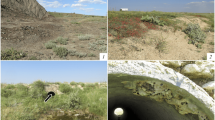Summary
Intruders were placed in the territory of a colony of the antNovomessor albisetosus Mayr. The colony attacked non-resident adults (N. albisetosus, Novomessor cockerelli) most violently, but threatened nestmates removed for three and for thirty-five days andN. cockerelli most often (=>40% of their respective groups). Mortality of former nestmates rose steadily with increasing time absent from the nest; all non-resident adults (includingPogonomyrmex badius) were killed. Many residents did not participate in attacks; recruitment from the nest was insignificant. Foreign congeneric adults evoked least investigation. Colonists transported foreign callows and pupae most often and longest; nestmates absent from the nest for three days were groomed more than other groups. Intruders reacted to residents by curling or flattening their bodies, investigation, flight or attack.
Zusammenfassung
In das Gebiet einer Kolonie der AmeiseNovomessor albisetosus Mayr wurden Eindringlinge gesetzt. Die Kolonie griff die nicht dort wohnenden Adulten (N. albisetosus, Novomessor cockerelli) am heftigsten an, aber bedrohte Koloniengenossen die für drei bzw. fünfunddreissig Tage entfernt worden waren undN. cockerelli am häufigsten (->40% ihrer respectiven Gruppen). Die Sterblichkeitsrate der früheren Nestgenossen stieg ständig an je länger sie vom Nest entfernt waren; alle nicht dort wohnenden Adulten (einschliesslichPogonomyrmex badius) wurden getötet. Viele Bewohner nahmen nicht an den Angriffen teil; Rekrutierung vom Nest war unbedeutend, Fremde congenerische Adulte riefen die wenigste Untersuchung hervor. Kolonie angehörige transportieren fremde junge Adulte und Puppen am längsten und häufigsten; Nestgenossen, die drei Tage vom Nest entfernt worden waren, wurden länger geputzt als andere Gruppen. Eindringlinge reagierten gegenüber Bewohnern mit Einrollen oder Flachmachen des Körpers, Untersuchung, Flucht oder Angriff.
Similar content being viewed by others
References
Avebury J.L., 1917. — Ants, Bees, and Wasps. D. Appleton and Company, New York, 448 p.
Baroni Urbani C., 1979. —Territoriality in social insects. InHermann (H.R.), ed., Social Insects, Vol. I. Academic Press, New York, 437 p.
Cammaerts-Tricot M.C., 1975. — Ontogenesis of the defence reactions in the workers ofMyrmica rubra L. (Hymenoptera: Formicidae).Anim. Behav., 23, 124–130.
Creighton W.S., 1950. — Ants of North America.Bulletin of the Museum of Comparative Zoology at Harvard College, 104, 1–585.
Creighton W.S., 1955. — Studies of the distribution of the genusNovomessor (Hymenoptera: Formicidae).Psyche, 62, 89–97.
Czechowski W., 1979. — Competition betweenLasius niger (L.)and Myrmica rugulosa Nyl. (Hymenoptera, Formicidae).Ann. Zool., 34, 437–451.
De Vroey C., Pasteels J.M., 1978. — Agonistic behaviour ofMyrmica rubra L..Ins. Soc., 25, 247–265.
Elton C., 1932. — Territory among wood ants (Formica rufa L.) at Picket Hill.J. Anim. Ecol., 1, 69–76.
Fielde A.M., 1901. — A study of an ant.Proc. Acad. Nat. Sci. Phila., 53, 425–449.
Fielde A.M., 1902. — Notes on an ant.Proc. Acad. Nat. Sci. Phila., 54, 599–625.
Fielde A.M., 1904. — Power of recognition among ants.Biol. Bull., 7, 227–250.
Fresneau D., 1980. — Fermeture des societes et marquage territorial chez des fourmis ponerines du genreNeoponera.Biologie-Ecologie méditerranéenne, 7, 205–206.
Gamboa G.J., 1975. — Ant-carrying in the desert leaf-cutter antAcromyrmex versicolor versicolor (Pergande) (Hymenoptera: Formicidae).Ins. Soc., 22, 75–82.
Headley A.E., 1941. — A study of nest and nesting habits of the antLasius niger subsp.alienus var.americanus Emery.Ann. Ent. Soc. Am., 34, 649–657.
Hermann H.R., Blum M.S., 1981. —Defensive mechanisms in the social hymenoptera. InHermann (H.R.), ed., Social Insects, Vol. II. Academic Press, New York, 491 p.
Hölldobler B., Wilson E.O., 1977. — The number of queens: an important trait in ant evolution.Naturwissenschaften, 64, 8–15.
Jutsum A.R., 1979. — Interspecific aggression in leaf-cutting ants.Anim. Behav., 27, 833–838.
Jutsum A.R., Saunders T.S., Cherrett J.M., 1979. — Intraspecific aggression in the leaf-cutting antAcromyrmex octospinosus.Anim. Behav., 27, 839–844.
Le Masne G., 1965. — Les transports mutuels autour des nids deNeomyrma rubida Latr.: Un nouveau type de relations inter-spécifiques chez les fourmis?Comptes rendus du V c Congrès de l'Union Internationale pour l'Etude des Insectes Sociaux, 303–320.
Le Moli F., Parmigiani S., 1981. — Laboratory and field observations of attack by the red wood antFormica lugubris onFormica cunicularia (Hymenoptera: Formicidae).Aggressive Behav., 7, 341–350.
Le Roux A.M., Leroux G., 1979. — Activité et agressivité chez des ouvrières deMyrmica laevinodis Nyl. (Hymenoptere, Formicides). Modification en fonction du groupement et de l'expérience individuelle.Ins. Soc., 26, 354–363.
Levings S.C., Franks N.R., 1982. — Patterns of nest dispersion in a tropical ground ant community.Ecology, 63, 338–344.
Mabelis A.A., 1979. — Wood ant wars: the relationship between aggression and predation in the red wood ant (Formica polyctena Först.).Neth. J. Zool., 29, 451–620.
Pontin A.J., 1961. — Population stabilization and competition between the antsLasius flavus (F.) andL. niger (L.).J. Anim. Ecol., 30, 47–54.
Provost E., 1979. — Etude de la fermeture de la société de fourmis chez diverses espèces deLeptothorax et chezCamponotus lateralis (Hyménoptères Formicidae).C. R. Acad. Sc. Paris, 228, 429–432.
Scherba G., 1964. — Analysis of inter-nest movement by workers of the antFormica opaciventris Emery (Hymenoptera: Formicidae).Anim. Behav., 12, 508–512.
Sokal R.R., Rohlf F.J., 1981. —Biometry. 2nd edition. W. H. Freeman and Company, San Francisco, 859 p.
Sudd J.H., 1967. —An Introduction to the Behavior of Ants. St. Martin's Press, New York, 200 p.
Wallis D.I., 1962 a. — Behaviour patterns of the ant,Formica fusca.Anim. Behav., 10, 105–111.
Wallis D.I., 1962 b. — Aggressive behaviour in the ant,Formica fusca.Anim. Behav., 10, 267–274.
Wallis D.I., 1963. — A comparison of the response to aggressive behaviour in two species of ants,Formica fusca andFormica sanguinea.Anim. Behav., 11, 164–171.
Wheeler W.M., 1900. — A study of some Texas Ponerinae.Biol. Bull., 2, 1–31.
Wheeler W.M., Creighton W.S., 1934. — A study of the ant generaNovomessor andVeromessor.Proc. Am. Acad. Sci., 69, 341–385.
Whitford W.G., 1978. — Structure and seasonal activity of Chihuahuan desert ant communities.Ins. Soc., 25, 79–88.
Whitford W.G., Depree E., Johnson P., 1980. — Foraging ecology of two Chihuahuan desert ant species:Novomessor cockerelli andNovomessor albisetosus.Ins. Soc., 27, 148–156.
Wilson E.O., 1971. —The Insect Societies. Belknap Press, Cambridge (Mass.), 548 p.
Author information
Authors and Affiliations
Rights and permissions
About this article
Cite this article
Goldstein, M.H., Topoff, H. Reaction of the antNovomessor albisetosus Mayr to intruders in the nest area (Hymenoptera: Formicidæ). Ins. Soc 32, 173–185 (1985). https://doi.org/10.1007/BF02224231
Received:
Accepted:
Issue Date:
DOI: https://doi.org/10.1007/BF02224231



